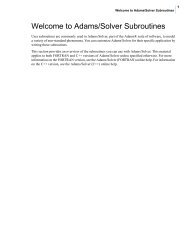Create successful ePaper yourself
Turn your PDF publications into a flip-book with our unique Google optimized e-Paper software.
<strong>ICAM</strong> <strong>Virtual</strong> <strong>Machine</strong> ® Version 19.0 Creating <strong>Virtual</strong> <strong>Machine</strong> Models with Quest<br />
Adding Physical Entities to the Model<br />
3.5 Adding Physical Entities to the Model<br />
Once you have defined the kinematics framework of your machine, you are now ready to add<br />
physical entities such as tables, heads, bases, etc. These objects give substance to your model so<br />
it can be seen, but more importantly, it is the physical entities of the model on which collision<br />
testing is performed.<br />
Entities are attached to axes or other entities in the same way that axes are attached to each other<br />
and the machine. Objects that are attached to moving axes will move when that axis moves.<br />
Sometimes, a physical entity on the machine will have some of its parts attached to one axis and<br />
the remainder attached to another axis. For example, a rotary table base would be attached to one<br />
axis (e.g., a linear axis), while the table itself would be attached to the rotary axis (so it rotates<br />
when the rotary axis moves). Another example: An X-axis table would be attached to the X-axis,<br />
but the guide-ways and base would be attached to the world.<br />
All entities are located in terms of an XYZ offset from their parent object. An offset of zero<br />
would place the entity origin at the same position as the parent object‟s origin. In the examples to<br />
this point, the axes have been defined at the machine origin. Doing so allows us to define geometry<br />
in terms of the machine coordinate frame. If machine dimensions are relative to some other<br />
position, then you should create a “Reference Axis” attached to the “<strong>Machine</strong>01” object and<br />
define the offset to the reference point used by the machine tool builder. All other objects should<br />
then be defined in the tree leading out from the reference axis.<br />
The following entity types can be created using the Simulation»Construct Entity menu bar<br />
selection (and also from the buttons on the VM Construct toolbar shown circled above):<br />
� A Cube is a box defined by its width, length and height.<br />
� A Cylinder is defined by a length and radius at each end.<br />
� A Cone is also defined by a length and radius at each end.<br />
� A Sphere is defined by a radius.<br />
� A Revolved is a 2D profile shape revolved about its local Z-axis.<br />
� An Extruded is a 2D profile shape extruded along its local Z-axis.<br />
� A Mesh is an STL object imported from the CAD/CAM system.<br />
� A Picture is a bitmap image.<br />
All entities share some common parameters (a description of entity parameters can be found<br />
starting on page 96).<br />
Do the following to add a base, X table and C rotary table entities to the kinematics model<br />
constructed in the previous section:<br />
46 <strong>ICAM</strong> Technologies Corporation – Proprietary















